Rampaging Red Bull in a class of its own at start of 2023 F1 season
After the first two races of 2023 — the Bahrain and Saudi Arabian Grands Prix — the Red Bulls of Verstappen and Perez are uncatchable. Mark Hughes relives the Middle East action
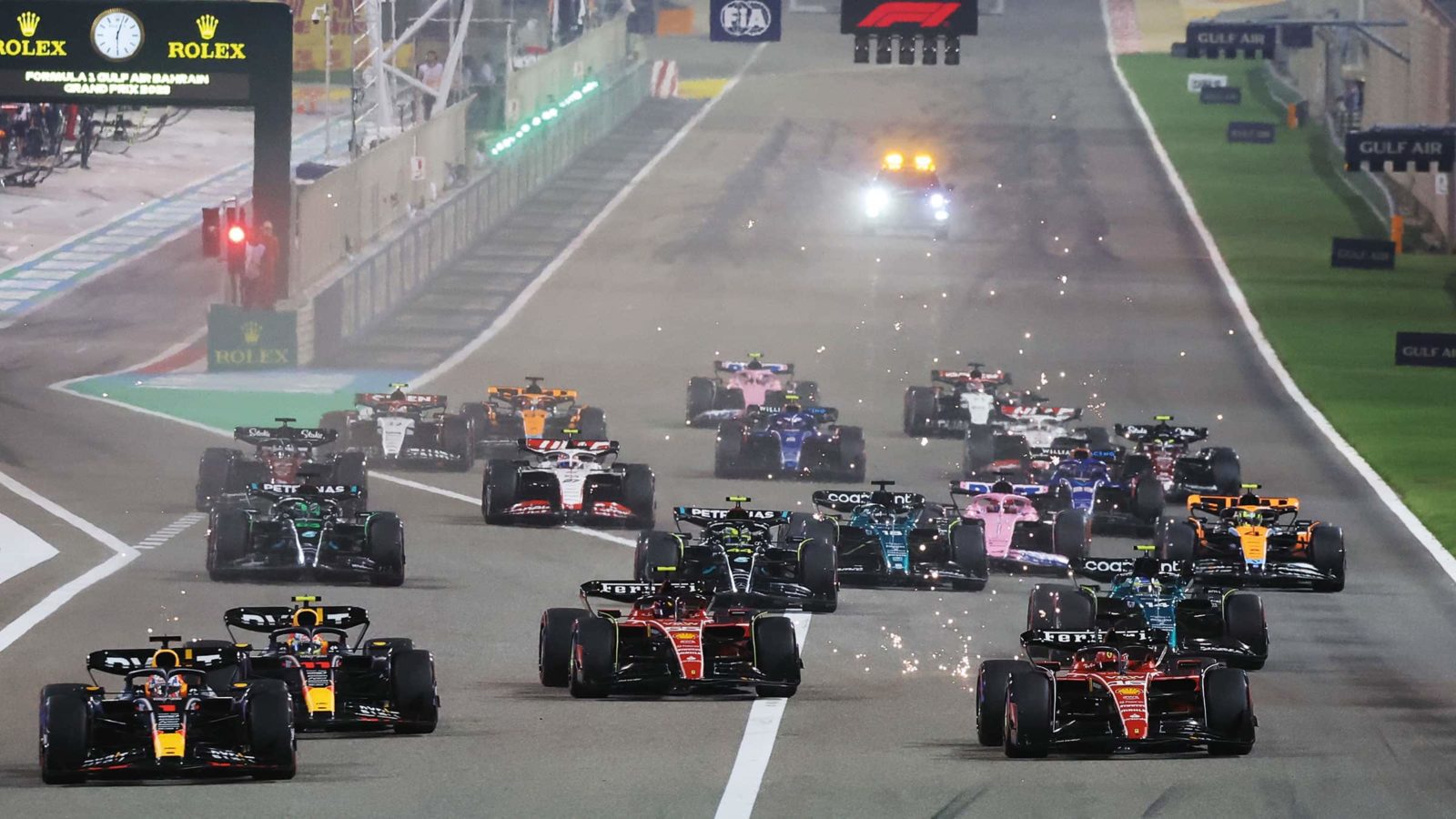
Max Verstappen, far left, leads at the Bahrain Grand Prix. Sergio Pérez lost second place to a quick Charles Leclerc
Grand Prix Photo
As the 2023 season got underway in Bahrain with a Red Bull-Honda performance advantage apparently even greater than last year (when the team scored 17 victories from 22), so the pressure on the competition began to tell. The realisation at Mercedes and Ferrari that they had something fundamentally wrong in their organisations led to speculation of crisis at both teams.
Ferrari’s chief of performance engineering David Sanchez quit after Bahrain, with the possibility of others following him. Confronting the reality of a second successive mediocre car as he chases that elusive record-breaking eighth title, Lewis Hamilton, now 38, was deflated and untypically spoke out against Mercedes.
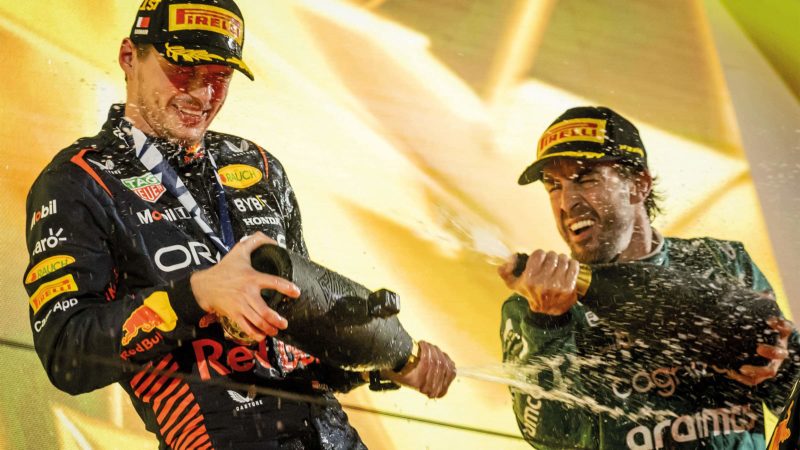
Max Verstappen and Fernando Alonso in Bahrain – Alonso’s first podium since 2021
That’s how soul-destroying Max Verstappen’s Bahrain victory was. It wasn’t so much that he was over half a minute clear of the nearest non-Red Bull (Fernando Alonso’s Aston Martin), it was how much bigger it could have been if he’d let himself off the leash. His engineer Gianpiero Lambiase was almost pleading with him to slow by 0.7sec per lap, even at a pace Verstappen considered comfortable. He eventually complied, yet still won with such an impressive margin.
“We’ve got them potentially 1.5sec faster in the race per lap”
“The gap is greater than last year,” said Hamilton, uninterested in varnishing the truth. “It’s not on the straights – last year we were very draggy with a much bigger wing, but equalling in the corners; this year it’s mostly corners. They have a lot of rear end on the exits through most of the corners. In the race they weren’t pushing. They’re a lot quicker than they even seemed. We’ve got them potentially 1.5sec faster in the race per lap.”
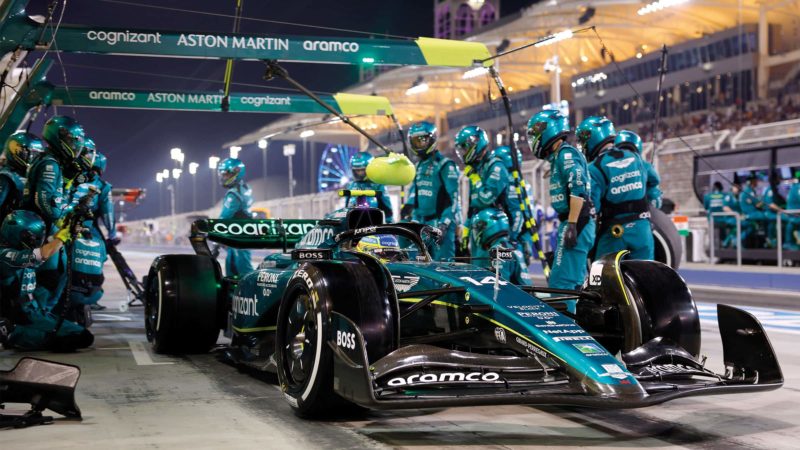
Alonso in the Bahrain pit
Aston Martin
Bahrain and the following Saudi Arabia Grand Prix confirmed that F1 is in the midst of a long-term competitive hierarchy change. Red Bull, semi-competitive by the end of 2020 after almost seven years of Mercedes rule, fully competitive in ’21, dominant in ’22 and seemingly extravagantly so in 2023. Despite a change of formula in the middle of that sequence.
The principle of entropy always prevails eventually and old alliances are broken down by an ascendant new power. It happened to Red Bull at the beginning of the hybrid formula and it’s taken this long to get back. It could take just as long for Mercedes or Ferrari to be anything other than occasional interlopers in a new Red Bull era. Which is what they were last year, but the assumption was that with a greater understanding of the ground effect cars in the second year of these regulations, they’d close the gap.
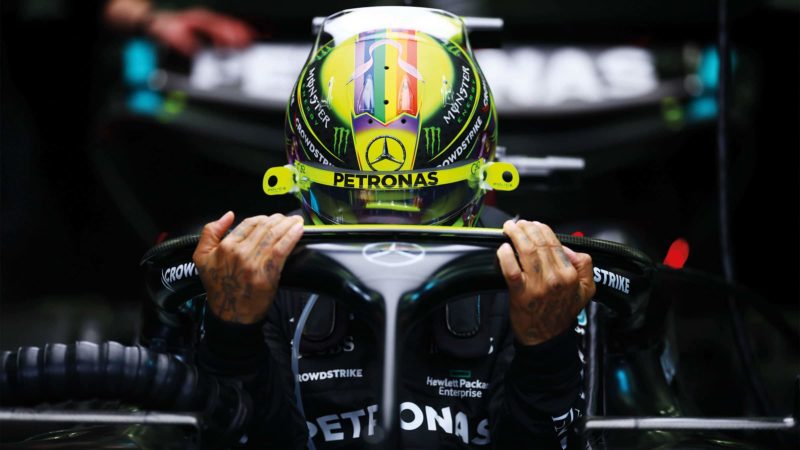
Lewis Hamilton was 50sec off Max in Sakhir
Getty Images
Carlos Sainz – a distant fourth in Bahrain after team-mate Charles Leclerc retired from third with a power unit failure – summarised the situation: “It’s simply a sign that there’s someone out there just doing a better job than us and that we need to raise the bar. But while we are raising the bar every year and becoming a stronger team, the others are doing the same… It’s not only how much you can progress from one year to another, it’s how much you can progress relative to the rest of the field. I’ve been in Ferrari three years and the progress I’ve seen inside the team from 2021 to 2023 is huge. But it hasn’t been enough to beat either Red Bull or Mercedes.”
Red Bull’s understanding of the aerodynamic nuances of the powerful underbodies clearly far exceeds that of its rivals. The RB19 looks very little different to its 2022 predecessor – a realigned sidepod, an even more extreme degree of anti-dive in the front suspension geometry and anti-squat in the rear – yet it’s around a second per lap faster. This despite the regulation tweak of the raised floor edge and diffuser, which was expected to cost around 0.5sec of lap time. If the competition assumed Red Bull would be into diminishing returns because of how high it had set the bar in 2022, and that they would be able to cut into that deficit, they were wrong.
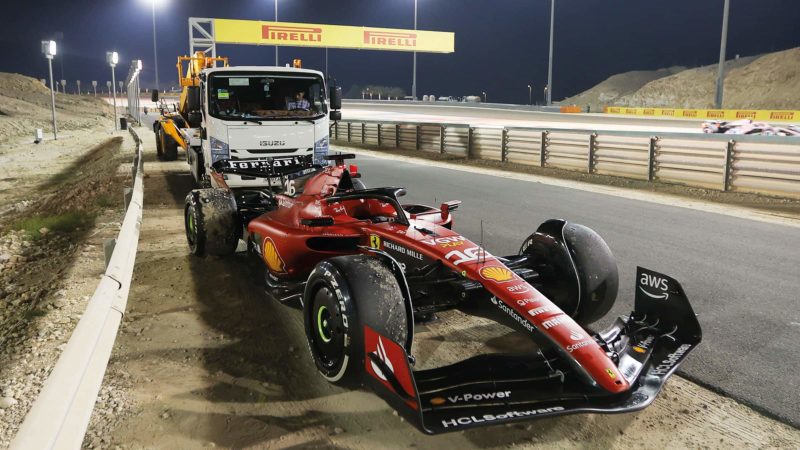
Leclerc was running third in the Bahrain Grand Prix but only lasted 40 laps
Bahrain presents a severe challenge to the rear tyres, so much so that the cars have to be set up with a protective amount of understeer, so compromising their balance for qualifying. The track surface is extremely abrasive and there is very little respite from long-duration quickish corners, punctuated by low-speed acceleration. The track varies a lot from day to day and what had worked during the three-day test the previous week wasn’t ideal during the GP weekend. That concerned Verstappen, but needn’t have done. So much pace did he have in hand, he could afford to run a little more of his hated understeer balance and still be on pole – albeit only 0.14sec quicker than his understeer-preferring team-mate Sergio Pérez.
Verstappen’s relatively small 0.3sec advantage over the Ferraris filling the second row flattered the red cars and was a reflection only of how far the Red Bull engineers had felt able to afford to prioritise race day performance at the expense of qualifying. He won the start and none of the others saw him until the race was over.

Business as usual for the 2022 world champion in qualifying at Bahrain – the Red Bull was quick
Pérez’s race was a little more complicated, as he was beaten into the first corner by the new-tyred Leclerc. But such was the Red Bull’s superior tyre usage that he – like Verstappen – was able to use another set of softs into the second stint whereas everyone else, Leclerc included, was obliged to switch to mediums. Using his tyre advantage, Pérez was able to pass the Ferrari early into the second stint.
Leclerc was probably set for a distant third, but only because Alonso had lost time and places on the first lap to being hit at Turn 4 by team-mate Lance Stroll. But even that was denied Ferrari, as Leclerc was forced to retire with an energy store-related failure. This had already been replaced pre-race and the necessity of a third item for Saudi would result in a 10-place grid penalty there.
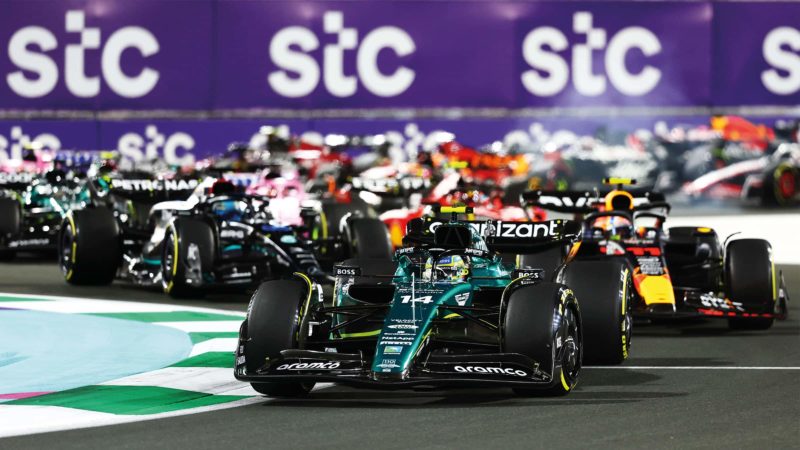
Just like old times for Alonso – leading the early stages of the Saudi Arabian Grand Prix
Alonso’s first lap began going wrong as Hamilton out-braked him into Turn 4. Alonso is a master of the switchback re-pass, however, and it looked like that’s what his intention was as he didn’t even defend the inside but stayed out wide, ready to swoop aggressively for the apex on an ideal line as Hamilton would be compromised on the exit by his narrow approach angle. The problem was that as Alonso was making that swoop, just behind him Stroll was braking late on the inside to defend his place against Russell alongside. Alonso’s sharp dive caught him by surprise and he had no braking power left in reserve and so hit the sister car, losing both of them momentum. It was enough for Russell to flash by Stroll into the turn and then zap Alonso. Stroll was driving with a fractured wrist after a cycling accident.
“Verstappen had adopted radio silence when asked to control his pace”
Remarkably, neither Aston was damaged but it ensured they’d both have busy races. Alonso drove masterfully, just keeping his distance behind the two Mercs, so as not to stress his tyres before then applying the pressure as their tyres began to fade. He went by Russell in a move which lasted from Turn 3 to Turn 6 before then pulling a beautiful dummy on Hamilton to pass between Turn 9 and 10 – a highly unconventional overtaking spot. He followed this up with a particularly aggressive pass on Sainz into Turn 11. “We need to improve the straight-line speed,” he commented. “We’d like to be able to pass with DRS like everyone else. I had to get creative.” He gave every impression of being completely thrilled about his competitive rebirth in Formula 1 at 41 after almost a decade in the wilderness.
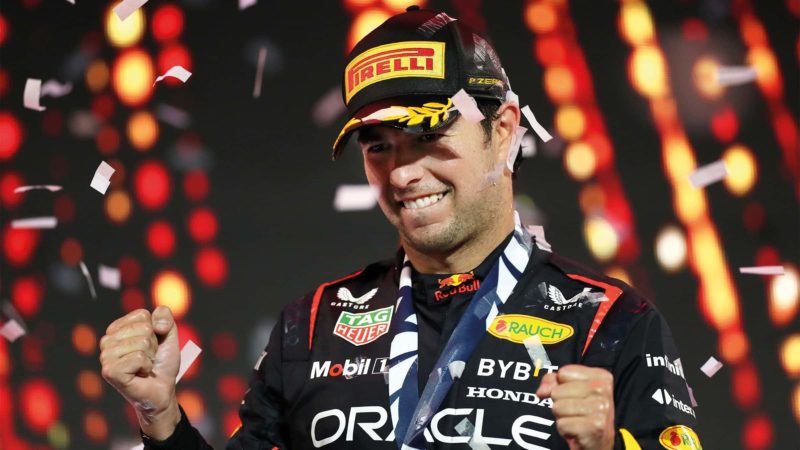
In Saudi Arabia Pérez took his GP career win tally to five. Red Bull has already struck fear into the hearts of Mercedes and Ferrari
Getty Images
Any hope that Bahrain’s unusual demands may have exaggerated Red Bull’s advantage were blown apart at Jeddah. Sergio Pérez won from pole after withstanding an onslaught of flat-out attack from Verstappen who’d started from 15th after a driveshaft failure in the Q2 part of qualifying. In the 28 laps between a safety car bunching up the field and the chequered flag falling, they pulled out 20sec on the best-of-the-rest (Alonso’s Aston Martin again), an average of 0.7sec per lap.
Verstappen had adopted radio silence when asked to control his pace because of a concern about a repeat of the driveshaft problem on both cars but even at his magnificent best he was only able to nibble away at the 5sec gap Pérez had established by the time Verstappen was up to second shortly after the safety car restart. Eventually he realised he just couldn’t do it, that Pérez was just too fast on the day to claw that amount of time back on him. But Verstappen did at least deliver the fastest lap of the race, the point for which is all that put him ahead of Pérez at the top of the F1 championship table. Two races in, Verstappen was acknowledging that the title looks set to be fought strictly between them.
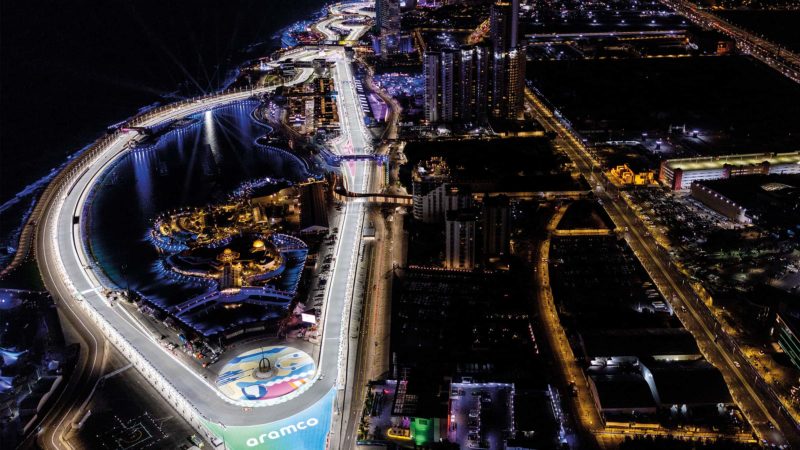
After Jeddah, Verstappen remains top of the Formula 1 world championship by a single point
Getty Images
Alonso put an Aston Martin in the lead of a grand prix for the first three laps before Pérez used the Red Bull’s greater straight-line speed and the DRS function to easily pass. Just as in Bahrain, the Aston was always just that little bit faster than Russell’s Mercedes, with Hamilton back in fourth after a qualifying session which left him feeling disconnected from the car and unable to commit to the fast corners between the walls of Sector 1. But he raced well enough, putting a nice pass on Sainz’s Ferrari along the way.
Sainz summarised Ferrari’s performance as follows: “I think the last stint on the hards proves we’re not where we want to be. We still deg more than the Mercs, we still deg more than the Astons, we still lack a bit of race pace. It’s tyre deg, balance, dirty air when following – we just struggle a bit. If we already overheat the tyres in clean air, imagine following. We just eat them alive and we need clean air to produce some kind of decent lap time. On the hards, I was pushing flat out, Charles was pushing flat out behind me and we just couldn’t keep up [with the Mercs]. I think this is just the true picture. The Merc and the Aston had maybe two or three tenths on us today but the Red Bull, at the beginning of the stints, they have a second in qualifying and then it opens up even more on a good Tarmac like here.”
“There were people who were close to Mattia who preferred to leave”
The Red Bull domination created some tension on its pitwall, but devastation in its wake. Talking of the Mercedes W14, an evolution of last year’s unusual aerodynamic concept, team boss Toto Wolff said, “I think we’d really tried hard to make it work, because the data that we have extrapolated showed us that this works. And we were proven wrong, very simply. And you can see that the two quickest cars have a similar concept of how they generate performance, and it’s very different to ours.
“At a certain stage we came to the conclusion, we got this wrong. Simply, we got it wrong. Why we got it wrong, we’re still analysing because we follow data and we followed what simulations tell us. In that case we were misguided by those data. And all of us involved in the decision-making process came to the conclusion that we can’t continue that way. We really tried to stick to it and we don’t want to, under any circumstance, run in a one-way street saying, ‘We’re going to make this work no matter what,’ because it doesn’t work. And I don’t want to lose more time.”
Ferrari team principal Frédéric Vasseur, on being asked about the departure of his technical chief, replied: “It is inevitable. There are people who were very close to [former principal] Mattia [Binotto] and who have preferred to leave; which doesn’t bother me. And there are others who may have feared for a moment for their future.”
That’s how the Red Bull shockwaves have been felt.

